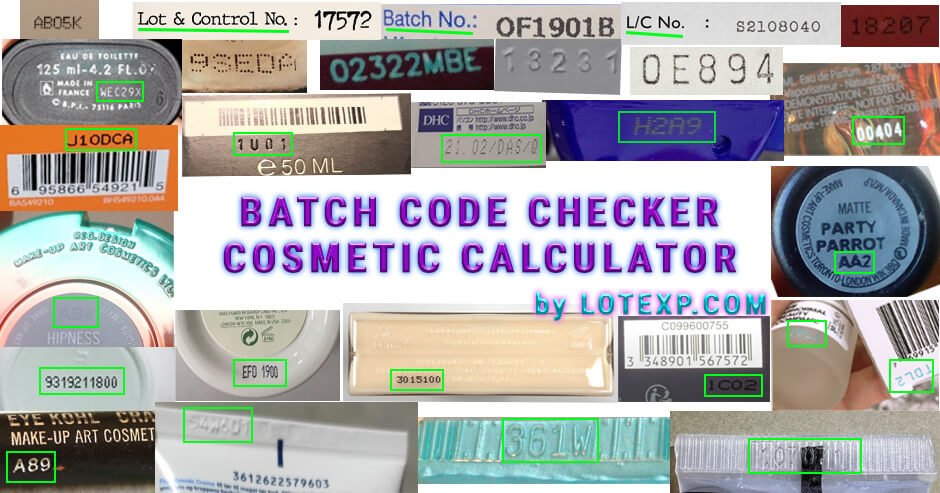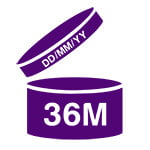Nowadays, all products have batch codes, and it’s almost a requirement. Some even include the batch code, the date of manufacture, and the expiration date. However, cosmetic products usually only have a batch code. Very few countries require the date of manufacture or expiration date to be printed or stamped on the product.
Having a batch code on products is necessary. But since it is abbreviated, not everyone can easily read it. Therefore, our team and many partners have tried to build a Cosmetic Calculator to help consumers quickly look up the product’s date of manufacture and calculate the expiration date more easily.
What is our Cosmetics Calculator Tool?
This tool decodes batch codes to determine the product’s manufacture date. Each company will have its way of encoding to easily trace the place of manufacture and production shift later. However, our tools only decode the date of manufacture. Knowing the date of manufacture will help predict the product’s expiration date.
Currently, more than 1160 brands are supported by Our Cosmetics Calculator: Supported Brands – Click Here
How to use the Checkcosmetic Tool?

Step 1: You must determine the product brand you want to search for. Select the brand you wish to search on the toolbar.
Tip: If you cannot determine the brand, you should try to search for the barcode or hotline on the product packaging on Google. You can take a picture of the product to search by Google image or send it to us for help.
Step 2: Identify the batch code on the product and enter it.
The batch code is usually printed or stamped on the bottom, the body of the product, or the packaging. It is generally Latin letters and numbers.

Note:
- The batch number is not a barcode.
- You can check the batch code you see with Google; if there are many results, it is usually not.
- Most batch codes are written in uppercase.
- Some characters can be confusing, for example, 0 – O, uppercase i – lowercase l, 6-G, 2-Z, etc.
- Some products have symbols such as LOT, Batch, BC, LN, (L), which means batch code; MAN, MFD, MFG, MD, 製造, 제조, 生产日期, 加工年月日 means manufacture date; EXP, ED, 까지, 保质期, 消费期限 means expiration date; BBE, BE, 賞味期限 means Best Before End.
Step 3: Press the CHECK button and await the result. If you cannot check, you can send an email with a picture of the product (or barcode) and the batch code (you should send a picture with the batch code because you may have misread some characters).
How long is the shelf life of cosmetics?
The shelf life of cosmetics depends on the manufacture date and the period after opening (PAO). In addition to the expiry date calculated from the date of manufacture, we need to pay attention to the PAO. Each type of cosmetic has a different period after opening.

Usually, PAO will be printed on the product packaging. If not, we can refer to the shelf life of some cosmetic lines as follows:
- Fragrance: >36 months.
- Makeup Powders: 12 – 36 months.
- Foundation in a jar or a cream powder: 12 – 36 months.
- Liquid tone means (in tubes or jars): 12 months.
- Nail polish: 12 months.
- Sunscreen: 12 months.
- Lipstick, lip gloss: 12 months.
- Pencil (Eye, Lip): 12 months.
- Skincare products with the pump: 6 – 10 months.
- Solid eyeliner and eyebrow pencil: 6 – 8 months.
- Natural/Organic products: >6 months.
- Bronzing: 6 months.
- Mascara: 3-6 months.
- Liquid eyeliner: 3 – 4 months.

Why do cosmetics companies use the batch number instead of the expiry date?
To understand this issue, we must understand what a batch code is.
A batch code is a short string of letters and numbers that helps the manufacturer mark the batch number, date of manufacture, and possibly the place of manufacture, type of product, production line, location of production (plant code, line number), and production shift in a shortened way. Thus, using a batch code will show more information, especially on small products. That also means that tracing later will be easier, especially when there is a product recall or litigation. The batch code is required for Good Manufacturing Practices (GMP).
Suppose when printing the manufacturing date on the beauty product. As we all know, cosmetics will not sell as well as other consumer goods. Most customers will choose products with newer manufacturing dates or longer expiration dates. Not marking the date of manufacture or expiration date will make it difficult for buyers to recognize old or new products. Then buying will be random, less old inventory products.
In addition, according to the views of some sellers, changing the Batch code form every year also helps to identify fake goods and makes it more difficult to counterfeit. However, relying on the batch code to trace authenticity is impossible, as some blog posts have posted.
How can we obtain batch code data to decode it?
We collect most batch code data from various sources such as email, sellers from many countries, the internet, etc.
When we receive a batch code from the email, our team will check, and we will send it to partners who are sellers in other countries to collect more codes. We aggregate all the data. If lucky, we may receive many batch codes with the date of manufacture or expiration date. When collecting a large amount, our team will decode or contact the supporters of the brands to ask. However, it is not always can be decoded.
Is the batch code checker tool accurate?
Most batch codes we decode are cross-checked and tested on many different batch codes before the formula is released. However, it may be correct at a certain point in time because the brand can change constantly. And we will change and update as quickly as possible.
In addition, the same type of batch code but each country, region, or product line will have different decoding methods, which we may not know. For example, CODE 201123 has the same 6-digit code type, but some countries mark the year before the month, and some countries mark the year after the month, which will cause a conflict whether 2020 and 2023. However, during the decoding process, only some brands have this happen.
Currently, there are many types of batch codes from many brands that we cannot decode in time, and we hope you can contribute more batch codes if you cannot check for us to have more data to decode.
